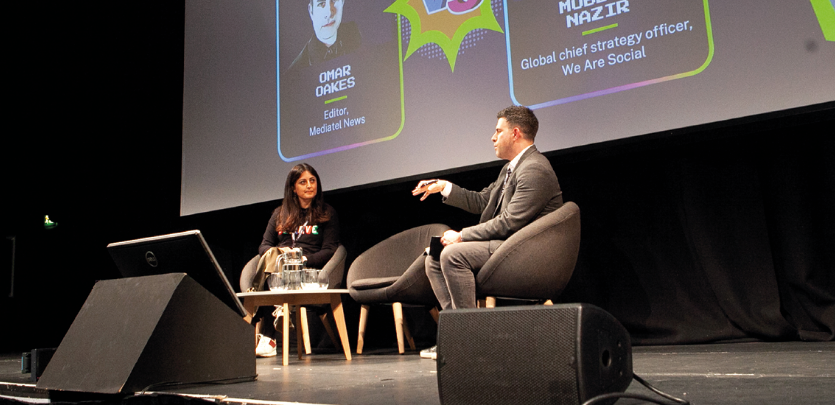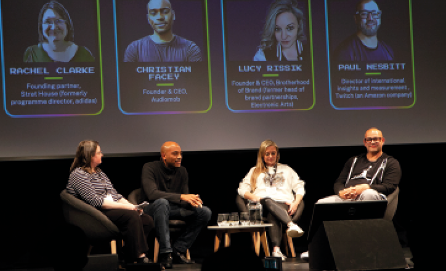Advertising to the Avatars

Posted on Aug 3, 2022 by FEED Staff
FEED attended its first real-world event in months – and learned that advertisers need a game plan
The pandemic has reached a stage where people feel that we’re almost out of the woods, just to be told that we may have only now entered the woods. But, maybe we’re safe to camp here for a while? Can anyone get a phone signal? Hey, we’ve just run out of toilet paper. Oh no, rabid wolves! Run for your life…
UK tech events company Mediatel rolled the dice and decided to go ahead with the in-venue component of its The Future of TV Advertising and The Future of Gaming summits at the end of 2021.
Given the circumstances, there was a relatively high turnout at the King’s Cross, London venue, with The Future of TV Advertising taking place in the morning and The Future of Gaming in the afternoon.
One gets the sense that being deprived of in-person events for so long has actually helped some people renew themselves. Many of us have re-evaluated aspects of our lives. Even if we haven’t kept up with all
our lockdown hobbies, we’re a bit more in touch with what brings us joy and how precious life is.
The one-on-one conversations I had were friendly, cutting to the chase with very little pretence – as if people were gazing into each other’s eyes, saying silently: “I know you almost threw up into the sink this morning when you were swabbing your tonsils. Me too, sister. Me too.” Might the pandemic have made us all a bit more humble, tolerant and open? Let’s just watch this space.
To the point: the dual Mediatel events had a particular focus on the relationship – not always smooth – between new media and marketing. FEED focused its attention primarily on The Future of Gaming track.
Mass appeal
Some fascinating groundwork was laid by Matthew Walker, a Credit Suisse research analyst specialising in media and gaming. Walker delivered ‘A view from the city’, his assessment of how much potential revenue the gaming industry holds for investors. We all like to imagine how big – or busted – a particular sector is, but those impressions are often guesses, or based solely on the latest headlines. Getting the sober facts from a major international financial institution is thoroughly enlightening.
The gaming industry is worth $175 billion, according to Walker. Three billion people play games, with an average age of 34 and a pretty equal 46/54% split between women and men. It’s also one of the cheapest forms of entertainment, trailing only behind music.
Mobile and free-to-play games are expected to make up most of the future growth. Cloud gaming is a sector that’s going places, but Walker thinks it will still be a long time before gaming consoles are fully consigned to the dump.
Gaming is projected to be one of the highest-growth media industries in the next few years, second only to digital advertising.
Walker’s analytics were designed to advise whether games companies were a good investment; but it was surprising that esports was left out of his presentation. While a professional competition may not always be affiliated with the company who produced the game, the potential for new titles becoming a hit among pros is surely something investors should keep an eye on.
FEED attended its first real-world event in months – and learned that advertisers need a game plan
The pandemic has reached a stage where people feel that we’re almost out of the woods, just to be told that we may have only now entered the woods. But, maybe we’re safe to camp here for a while? Can anyone get a phone signal? Hey, we’ve just run out of toilet paper. Oh no, rabid wolves! Run for your life…
UK tech events company Mediatel rolled the dice and decided to go ahead with the in-venue component of its The Future of TV Advertising and The Future of Gaming summits at the end of 2021.
Given the circumstances, there was a relatively high turnout at the King’s Cross, London venue, with The Future of TV Advertising taking place in the morning and The Future of Gaming in the afternoon.
One gets the sense that being deprived of in-person events for so long has actually helped some people renew themselves. Many of us have re-evaluated aspects of our lives. Even if we haven’t kept up with all
our lockdown hobbies, we’re a bit more in touch with what brings us joy and how precious life is.
The one-on-one conversations I had were friendly, cutting to the chase with very little pretence – as if people were gazing into each other’s eyes, saying silently: “I know you almost threw up into the sink this morning when you were swabbing your tonsils. Me too, sister. Me too.” Might the pandemic have made us all a bit more humble, tolerant and open? Let’s just watch this space.
To the point: the dual Mediatel events had a particular focus on the relationship – not always smooth – between new media and marketing. FEED focused its attention primarily on The Future of Gaming track.
Mass appeal
Some fascinating groundwork was laid by Matthew Walker, a Credit Suisse research analyst specialising in media and gaming. Walker delivered ‘A view from the city’, his assessment of how much potential revenue the gaming industry holds for investors. We all like to imagine how big – or busted – a particular sector is, but those impressions are often guesses, or based solely on the latest headlines. Getting the sober facts from a major international financial institution is thoroughly enlightening.
The gaming industry is worth $175 billion, according to Walker. Three billion people play games, with an average age of 34 and a pretty equal 46/54% split between women and men. It’s also one of the cheapest forms of entertainment, trailing only behind music.
Mobile and free-to-play games are expected to make up most of the future growth. Cloud gaming is a sector that’s going places, but Walker thinks it will still be a long time before gaming consoles are fully consigned to the dump.
Gaming is projected to be one of the highest-growth media industries in the next few years, second only to digital advertising.
Walker’s analytics were designed to advise whether games companies were a good investment; but it was surprising that esports was left out of his presentation. While a professional competition may not always be affiliated with the company who produced the game, the potential for new titles becoming a hit among pros is surely something investors should keep an eye on.


A question of evolution
Lucy Rissik, founder and CEO of Brotherhood of Brand, as well as a member of the executive board for Women in Games, reminded us of the virtually even split between women and men in gaming consumption. But, only one in five people in the industry itself are women.
“The games industry is going through an evolution, recognising women much more,” said Rissik. “And one of the best recent releases has to be The Last of Us II, which had this fantastic female character who was a lesbian. It was an amazing thing to have as the protagonist in a game. And I think we’re going to see more of that.”
Games have become about much more than skill and competition – although this element remains. They are now social and transactional spaces, which allow more room for brands to reach out and interact with consumers.
Last year, fashion house Balenciaga conducted a virtual show in Fortnite, launching a collaboration which has resulted in digital in-game fashion. A whole new generation is now connected with the Balenciaga label. Moncler and other well-known names have followed suit, offering skins and in-game purchases across a variety of titles.
New in-game technologies for ad placement are also starting to take off. Companies like AudioMob now offer tech for unobtrusive, audio-based ads, and Bidstack have created world-appropriate ads within the game environment (read our piece on Bidstack at page 110).
The director of international insights and measurement at Twitch, Paul Nesbitt, described the unexplored depth of gaming audiences and their untapped potential: “When I speak to brands or agencies, I find many of them still think gamers are exclusively 14-year-olds in basements. But there’s a whole spectrum of ages there. They love social games – and many love esports – but guess what? Gamers don’t only love gaming. They can be into fashion, karaoke and beauty. These are normal people. Gamers make up nearly a third of the world’s population – they can’t all just be 14-year-old boys.”
This article first featured in the Spring 2022 issue of FEED.
Discussion archives
A question of evolution
Lucy Rissik, founder and CEO of Brotherhood of Brand, as well as a member of the executive board for Women in Games, reminded us of the virtually even split between women and men in gaming consumption. But, only one in five people in the industry itself are women.
“The games industry is going through an evolution, recognising women much more,” said Rissik. “And one of the best recent releases has to be The Last of Us II, which had this fantastic female character who was a lesbian. It was an amazing thing to have as the protagonist in a game. And I think we’re going to see more of that.”
Games have become about much more than skill and competition – although this element remains. They are now social and transactional spaces, which allow more room for brands to reach out and interact with consumers.
Last year, fashion house Balenciaga conducted a virtual show in Fortnite, launching a collaboration which has resulted in digital in-game fashion. A whole new generation is now connected with the Balenciaga label. Moncler and other well-known names have followed suit, offering skins and in-game purchases across a variety of titles.
New in-game technologies for ad placement are also starting to take off. Companies like AudioMob now offer tech for unobtrusive, audio-based ads, and Bidstack have created world-appropriate ads within the game environment (read our piece on Bidstack at page 110).
The director of international insights and measurement at Twitch, Paul Nesbitt, described the unexplored depth of gaming audiences and their untapped potential: “When I speak to brands or agencies, I find many of them still think gamers are exclusively 14-year-olds in basements. But there’s a whole spectrum of ages there. They love social games – and many love esports – but guess what? Gamers don’t only love gaming. They can be into fashion, karaoke and beauty. These are normal people. Gamers make up nearly a third of the world’s population – they can’t all just be 14-year-old boys.”
This article first featured in the Spring 2022 issue of FEED.
Discussion archives

